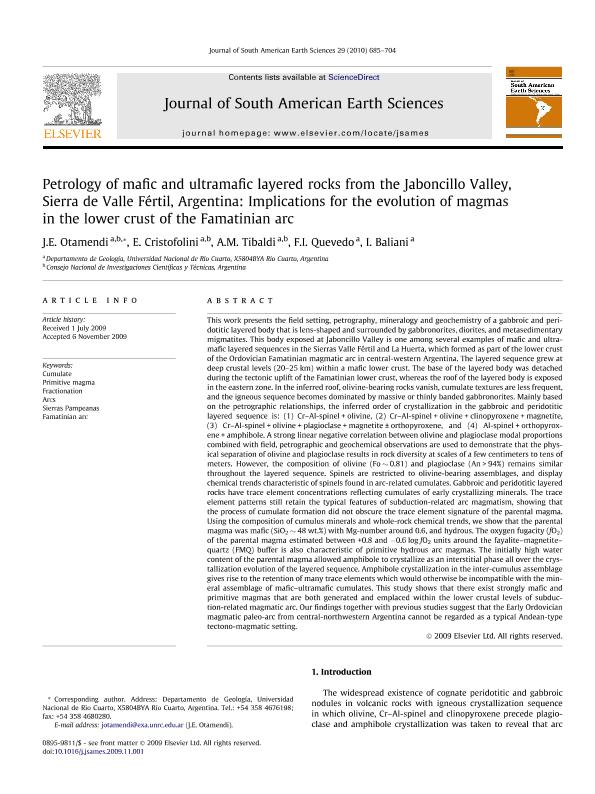Mostrar el registro sencillo del ítem
dc.contributor.author
Otamendi, Juan Enrique

dc.contributor.author
Cristofolini, Eber Ariel

dc.contributor.author
Tibaldi, Alina María

dc.contributor.author
Quevedo, F. I.
dc.contributor.author
Baliani Cocitto, Ignacio

dc.date.available
2023-02-17T19:25:04Z
dc.date.issued
2010-04
dc.identifier.citation
Otamendi, Juan Enrique; Cristofolini, Eber Ariel; Tibaldi, Alina María; Quevedo, F. I.; Baliani Cocitto, Ignacio; Petrology of mafic and ultramafic layered rocks from the Jaboncillo Valley, Sierra de Valle Fértil, Argentina: Implications for the evolution of magmas in the lower crust of the Famatinian arc; Pergamon-Elsevier Science Ltd; Journal of South American Earth Sciences; 29; 3; 4-2010; 685-704
dc.identifier.issn
0895-9811
dc.identifier.uri
http://hdl.handle.net/11336/188482
dc.description.abstract
This work presents the field setting, petrography, mineralogy and geochemistry of a gabbroic and peridotitic layered body that is lens-shaped and surrounded by gabbronorites, diorites, and metasedimentary migmatites. This body exposed at Jaboncillo Valley is one among several examples of mafic and ultramafic layered sequences in the Sierras Valle Fértil and La Huerta, which formed as part of the lower crust of the Ordovician Famatinian magmatic arc in central-western Argentina. The layered sequence grew at deep crustal levels (20–25 km) within a mafic lower crust. The base of the layered body was detached during the tectonic uplift of the Famatinian lower crust, whereas the roof of the layered body is exposed in the eastern zone. In the inferred roof, olivine-bearing rocks vanish, cumulate textures are less frequent, and the igneous sequence becomes dominated by massive or thinly banded gabbronorites. Mainly based on the petrographic relationships, the inferred order of crystallization in the gabbroic and peridotitic layered sequence is: (1) Cr–Al-spinel + olivine, (2) Cr–Al-spinel + olivine + clinopyroxene + magnetite, (3) Cr–Al-spinel + olivine + plagioclase + magnetite ± orthopyroxene, and (4) Al-spinel + orthopyroxene + amphibole. A strong linear negative correlation between olivine and plagioclase modal proportions combined with field, petrographic and geochemical observations are used to demonstrate that the physical separation of olivine and plagioclase results in rock diversity at scales of a few centimeters to tens of meters. However, the composition of olivine (Fo ∼ 0.81) and plagioclase (An > 94%) remains similar throughout the layered sequence. Spinels are restricted to olivine-bearing assemblages, and display chemical trends characteristic of spinels found in arc-related cumulates. Gabbroic and peridotitic layered rocks have trace element concentrations reflecting cumulates of early crystallizing minerals. The trace element patterns still retain the typical features of subduction-related arc magmatism, showing that the process of cumulate formation did not obscure the trace element signature of the parental magma. Using the composition of cumulus minerals and whole-rock chemical trends, we show that the parental magma was mafic (SiO2 ∼ 48 wt.%) with Mg-number around 0.6, and hydrous. The oxygen fugacity (fO2) of the parental magma estimated between +0.8 and −0.6 log fO2 units around the fayalite–magnetite–quartz (FMQ) buffer is also characteristic of primitive hydrous arc magmas. The initially high water content of the parental magma allowed amphibole to crystallize as an interstitial phase all over the crystallization evolution of the layered sequence. Amphibole crystallization in the inter-cumulus assemblage gives rise to the retention of many trace elements which would otherwise be incompatible with the mineral assemblage of mafic–ultramafic cumulates. This study shows that there exist strongly mafic and primitive magmas that are both generated and emplaced within the lower crustal levels of subduction-related magmatic arc. Our findings together with previous studies suggest that the Early Ordovician magmatic paleo-arc from central-northwestern Argentina cannot be regarded as a typical Andean-type tectono-magmatic setting.
dc.format
application/pdf
dc.language.iso
eng
dc.publisher
Pergamon-Elsevier Science Ltd

dc.rights
info:eu-repo/semantics/openAccess
dc.rights.uri
https://creativecommons.org/licenses/by-nc-nd/2.5/ar/
dc.subject
ARCS
dc.subject
CUMULATE
dc.subject
FAMATINIAN ARC
dc.subject
FRACTIONATION
dc.subject
PRIMITIVE MAGMA
dc.subject
SIERRAS PAMPEANAS
dc.subject.classification
Geología

dc.subject.classification
Ciencias de la Tierra y relacionadas con el Medio Ambiente

dc.subject.classification
CIENCIAS NATURALES Y EXACTAS

dc.title
Petrology of mafic and ultramafic layered rocks from the Jaboncillo Valley, Sierra de Valle Fértil, Argentina: Implications for the evolution of magmas in the lower crust of the Famatinian arc
dc.type
info:eu-repo/semantics/article
dc.type
info:ar-repo/semantics/artículo
dc.type
info:eu-repo/semantics/publishedVersion
dc.date.updated
2023-02-15T09:56:45Z
dc.identifier.eissn
1873-0647
dc.journal.volume
29
dc.journal.number
3
dc.journal.pagination
685-704
dc.journal.pais
Países Bajos

dc.journal.ciudad
Amsterdam
dc.description.fil
Fil: Otamendi, Juan Enrique. Universidad Nacional de Río Cuarto. Facultad de Ciencias Exactas, Fisicoquímicas y Naturales. Departamento de Geología; Argentina. Consejo Nacional de Investigaciones Científicas y Técnicas. Centro Científico Tecnológico Conicet - Córdoba; Argentina
dc.description.fil
Fil: Cristofolini, Eber Ariel. Universidad Nacional de Río Cuarto. Facultad de Ciencias Exactas, Fisicoquímicas y Naturales. Departamento de Geología; Argentina. Consejo Nacional de Investigaciones Científicas y Técnicas. Centro Científico Tecnológico Conicet - Córdoba; Argentina
dc.description.fil
Fil: Tibaldi, Alina María. Universidad Nacional de Río Cuarto. Facultad de Ciencias Exactas, Fisicoquímicas y Naturales. Departamento de Geología; Argentina. Consejo Nacional de Investigaciones Científicas y Técnicas. Centro Científico Tecnológico Conicet - Córdoba; Argentina
dc.description.fil
Fil: Quevedo, F. I.. Universidad Nacional de Río Cuarto. Facultad de Ciencias Exactas, Fisicoquímicas y Naturales. Departamento de Geología; Argentina
dc.description.fil
Fil: Baliani Cocitto, Ignacio. Universidad Nacional de Río Cuarto. Facultad de Ciencias Exactas, Fisicoquímicas y Naturales. Departamento de Geología; Argentina
dc.journal.title
Journal of South American Earth Sciences

dc.relation.alternativeid
info:eu-repo/semantics/altIdentifier/url/https://www.sciencedirect.com/science/article/pii/S0895981109001631
dc.relation.alternativeid
info:eu-repo/semantics/altIdentifier/doi/http://dx.doi.org/10.1016/j.jsames.2009.11.001
Archivos asociados
